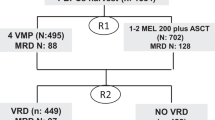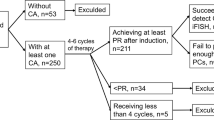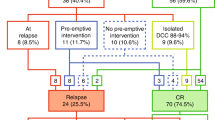Abstract
The clinical relevance of the assessment of minimal residual disease (MRD) in patients with multiple myeloma (MM) to predict disease recurrence has not been proven. In the present study, we retrospectively analyzed the tumor load in peripheral blood (PB) and bone marrow (BM) samples of 13 patients with MM both in remission after high-dose therapy (HDT) with autologous PBSC transplantation (PBSCT) and at the time of progressive disease (PD). For six patients, subsequent samples obtained in remission could be included in the study. Tumor cells were assessed by means of quantitative PCR with allele-specific oligonucleotides (ASO-qPCR) based on the method of limiting dilutions. PD was documented with ASO-qPCR in BM samples (median concentration of tumor cells in remission vs at PD: 0.18% vs 4.6%) representing a significant increase by a median factor of 8.7. In PB, the median tumor load was 799 cells/ml in remission and 23 400 cells/ml at PD. With a median factor of 45, the increase was much more pronounced. Comparing the results of the molecular monitoring in PB with those of the determination of the monoclonal protein, routinely applied as parameter for the course of the disease, revealed a superiority of the molecular monitoring because of the significantly higher increase in the tumor load. Analyzing the subsequent remission samples showed an increase of the malignant cells in four out of six PB samples and in all four BM samples available, indicating the potential of ASO-qPCR for an early PD recognition. Bone Marrow Transplantation (2001) 28, 957–962.
This is a preview of subscription content, access via your institution
Access options
Subscribe to this journal
Receive 12 print issues and online access
$259.00 per year
only $21.58 per issue
Buy this article
- Purchase on Springer Link
- Instant access to full article PDF
Prices may be subject to local taxes which are calculated during checkout



Similar content being viewed by others
References
Attal M, Harousseau JL, Stoppa AM et al. A prospective randomized trial of autologous bone marrow transplantation and chemotherapy in multiple myeloma New Engl J Med 1996 335: 91–97
Corradini P, Voena C, Tarella C et al. Molecular and clinical remissions in multiple myeloma: role of autologous and allogeneic transplantation of haematopoietic cells J Clin Oncol 1999 17: 208–215
Martinelli G, Terragna C, Zamagni E et al. Molecular remission after allogeneic or autologous transplantation of haematopoietic stem cells for multiple myeloma J Clin Oncol 2000 18: 2273–2281
Cremer FW, Ehrbrecht E, Kiel K et al. Evaluation of the kinetics of bone marrow tumor load in the course of sequential high-dose therapy assessed by quantitative PCR as predictive factor in patients with multiple myeloma Bone Marrow Transplant 2000 26: 851–858
Goldschmidt H, Martin H, Serke S et al. Tandem autologous transplantation (tpx) for multiple myeloma (MM): results of a German multicenter study Blood 1998 92: 662a (Abstr. 2730)
Goldschmidt H, Hegenbart U, Wallmeier M et al. High-dose therapy with peripheral blood progenitor cell transplantation in multiple myeloma Ann Oncol 1997 8: 234–246
Bladé J, Samson D, Reece D et al. Criteria for evaluating disease response and progression in patients with multiple myeloma treated by high-dose therapy and haematopoietic stem cell transplantation Br J Haematol 1998 102: 1115–1123
Vescio RA, Han EJ, Schiller GJ et al. Quantitative comparison of multiple myeloma tumor contamination in bone marrow harvest and leukapheresis autografts Bone Marrow Transplant 1996 18: 103–110
Cremer FW, Kiel K, Wallmeier M et al. A quantitative PCR assay for the detection of low amounts of malignant cells in multiple myeloma Ann Oncol 1997 8: 633–636
Kiel K, Cremer FW, Rottenburger C et al. Analysis of circulating tumor cells in patients with multiple myeloma during the course of high-dose therapy with peripheral blood stem cell transplantation Bone Marrow Transplant 1999 23: 1019–1027
Billadeau D, Prosper F, Verfaillie C et al. Sequential analysis of bone marrow and peripheral blood after stem cell transplant for myeloma shows disparate tumor involvement Leukemia 1997 11: 1565–1570
Rasmussen T, Jensen L, Honoré L, Johnsen HE . Frequency and kinetics of polyclonal and clonal B cells in the peripheral blood of patients being treated for multiple myeloma Blood 2000 96: 4357–4359
Rasmussen T, Johnsen HE . Controversies surrounding the circulating clonotypic B lymphocytes in multiple myeloma Blood 2001 97: 2913–2914 (letter)
Cremer FW, Goldschmidt H, Moos M . Clonotypic B cells in the peripheral blood of patients with multiple myeloma Blood 2001 97: 2913 (letter)
Gerard CJ, Olsson K, Ramanathan R et al. Improved quantitation of minimal residual disease in multiple myeloma using real time PCR and plasmid-DNA complementarity determining region III standards Cancer Res 1998 58: 3957–3964
Rasmussen T, Poulsen TS, Honoré L, Johnsen HE . Quantitation of minimal residual disease in multiple myeloma using an allele-specific real-time PCR assay Exp Hematol 2000 28: 1039–1045
Reiter A, Schrappe M, Ludwig WD et al. Intensive ALL-type therapy without local radiotherapy provides a 90% event-free survival for children with T-cell lymphoblastic lymphoma: a BFM group report Blood 2000 95: 416–421
Durie BGM, Salmon SE . A clinical staging system for multiple myeloma: correlation of measured myeloma cell mass with presenting clinical features, response to treatment and survival Cancer 1975 36: 842–854
Acknowledgements
We are indebted to Axel Benner for his important information regarding the statistical analysis and to Ileana Wenzel for her critical reading of the manuscript. The authors thank Hildegard Bethäuser, Edith Ehrbrecht, Carmen Kröner and Renate Schulz for excellent technical assistance.
Author information
Authors and Affiliations
Rights and permissions
About this article
Cite this article
Lipinski, E., Cremer, F., Ho, A. et al. Molecular monitoring of the tumor load predicts progressive disease in patients with multiple myeloma after high-dose therapy with autologous peripheral blood stem cell transplantation. Bone Marrow Transplant 28, 957–962 (2001). https://doi.org/10.1038/sj.bmt.1703276
Received:
Accepted:
Published:
Issue Date:
DOI: https://doi.org/10.1038/sj.bmt.1703276



